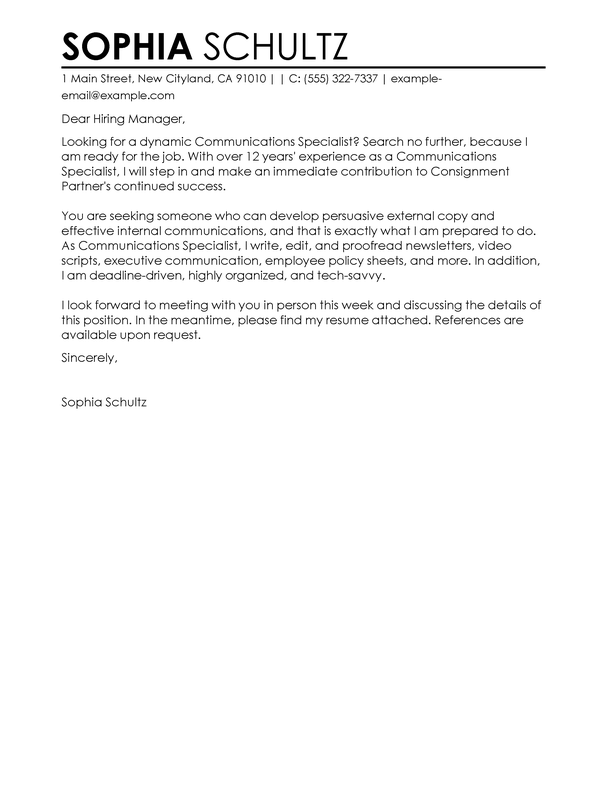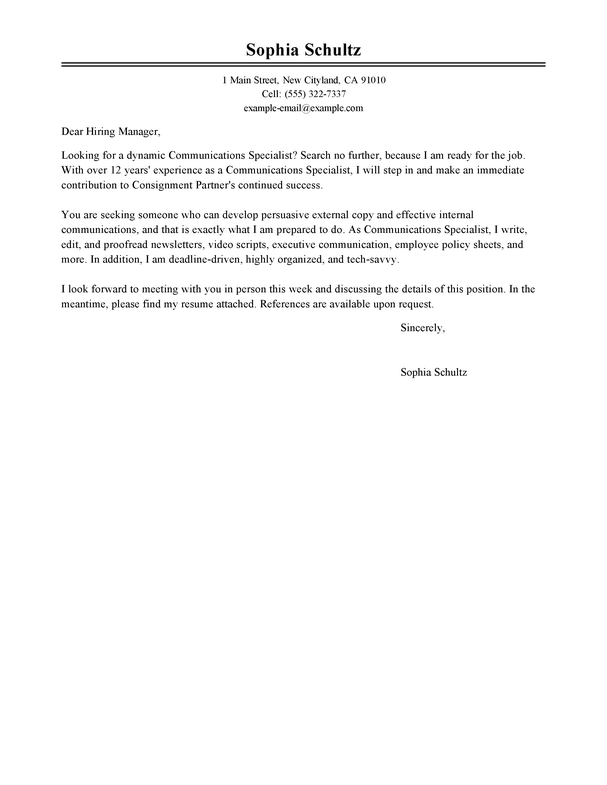Best Communications Specialist Cover Letter Examples
Published: Friday 28th of July 2017; Words Count: 1150
When you apply for a job, your cover letter is often the first thing a hiring manager will read. If you want to make sure your writing has the best chance of impressing a recruiter, use our communications specialist cover letter example and list of do’s and don’ts to fine-tune your own customized letter.
- Do spend some time building up your confidence so your writing reflects your most relevant communications skills and qualifications.
- Don’t start with “To Whom It May Concern.” If you don’t know the hiring manager’s name, use a specific greeting, such as “Communications Specialist Search Committee.”?Do focus on marketing yourself in a memorable way.
- Don’t use over-the-top language like “incredibly enthusiastic” or “job of a lifetime.” Be passionate but relatable.
- Do consider showcasing your communications creativity by choosing a unique format, such as including a header or using bullet points or a numbered list in your letter.
- Don’t be so unique or nontraditional that you come across as arrogant, flippant, or unprofessional.
Communications Specialist Advice
As a communications professional, you’ll be in charge of a variety of communication needs and initiatives for your company or clients. These cover letter examples can help you in developing your own communications specialist cover letter. Choose from a range of professional designs and find a format that fits your needs, and start writing your job-winning cover letter today. Click on any of the templates below to take the next step in your career!

Cover Letter Tips for Communications Specialist
Hunting for jobs as a Communications Specialist may feel challenging. Apply these five tips to make your search easier and possibly more productive:
1. View your job search as your main occupation for the time being. Attitude matters a lot, and you should prepare for a long search.
2. Get more training. It may be better to build on what you already know, instead of starting over from scratch. However, if you are ready for a big career change it may be time to learn a whole new skill or trade.
3. Identify your primary strengths and interests by taking aptitude assessments. You can usually do this online, or in person at local colleges, libraries or job centers.
4. Start your search online, but don’t ignore newspaper ads and public bulletin boards. Not all companies advertise their open positions on the Internet.
5. Go to job fairs, and be prepared to interview. Some job fairs are put on by single companies, and others bring together multiple employers. Career fairs often include representatives from diverse industries and training programs. All of these events can help you in your job search.

Communications Specialist Job Seeking Tips
Your search for jobs as a Communications Specialist starts with creating your cover letter. You’ll hand this document to prospective employers along with, or instead of, a job application, and they will read it to get a first impression of you. It’s important to take the time to create an outstanding cover letter, one that showcases why you are the person for the job. Follow these steps to create a strong cover letter:
1. List the most relevant information first. In the previous experience section, this means that you should list your position title, then the name of your employer, then the city and state where you were employed and then the dates of employment.
2. Focus on what you accomplished, not what your responsibilities were. Use action words instead of simply restating your job description.
3. Emphasize your transferrable skills. What did you do in your last job that will help you do your next job well? Highlight it on your cover letter, even if the two positions are entirely different.
4. List measureable results whenever possible. For example, how many accounts did you manage? How many people did you supervise? How many houses did you clean?
5. If you have work experience that is more than 15 years old, list it, but don’t emphasize it. Your most recent experience is likely the most relevant.





